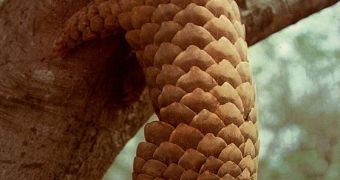1.The name "pangolin" comes from the Malay "pengguling" ("something that rolls up"). There are 7 species of pangolins: four in Africa and three in southeastern Asia. They are unique amongst mammals because of their hard and large scales covering their back, flanks, and Tails. The feet sides and the head are covered by smaller scales. These scales are not the same with the reptilian ones, being made of compressed hairs. The ventral parts have soft skin covered by rare hair.
2.Pangolins have conic bodies and very long tails, which can make two thirds of the body length. The feet ends in large claws. Some species have prehensile tails (which can grab). They vary in size from 0.8 ft (22 cm) to 1 m (3.3 ft).
3.Pangolins live from rain forests to savannas and open grasslands. They are all good climbers and two species are strictly arboreal. While arboreal pangolins roll on branches for sleeping, the ground pangolins dig dens, up to depths of several meters, sometimes with underground rooms that can be up to 2 m (6.6 ft) wide. Pangolins are mainly solitary.
4.These odd animals are specialized on feeding with ants and termites (they are also called 'scaly anteaters', but they are not related to the anteaters of South America). They find the food using their kin sense of smell. Ground species lean on the wide tail and use the strong claws of the fore limbs for tearing bit by bit ant and termite mounds.
The insects are collected using the long and sticky tongue, which is introduced into the nests. Tree pangolins attack the nests of the tree ants and termites.
5.The tongue of the giant pangolin (which is no longer than 1 m (3.3 ft)) is 70 cm (2.3 ft) long! It is the absolute record amongst mammals, and unique amongst all vertebrates, its muscle roots pass through the whole body of the animal, anchoring on the pelvis bone of the animal (in the genital area)!
6.Pangolins are toothless; insects are swollen whole and than crunched and ground in the hard stomach.
7.These animals breed depending on the species and habitat and some species seem to do it all year round. Most species give birth to just one offspring.
The offspring is born covered by soft scales which start to harden one day later. During the first weeks, the young pangolin is carried clung by its mother's tail and if a danger appears, she protects it rolling her body around its offspring's.
8.All pangolins defend through rolling on their body. The sharp scales are known to induce severe wounds even to the lions.
9.Pangolins also detain the record amongst mammals in what concerns the number of tail vertebrae: 46-47! That's more than the whole number of vertebrae in humans.
10.Despite the look, pangolins' closest relatives are the carnivorous mammals (cats and dogs).

 14 DAY TRIAL //
14 DAY TRIAL // 
